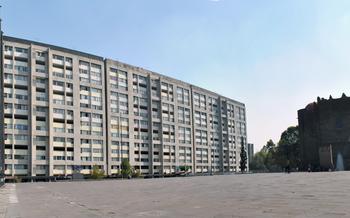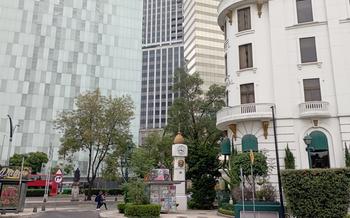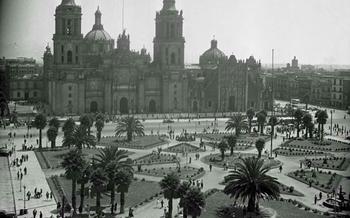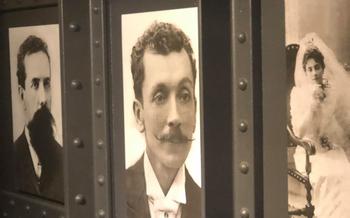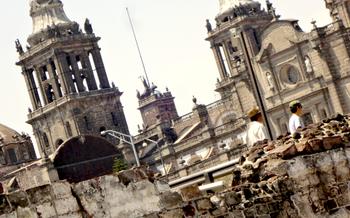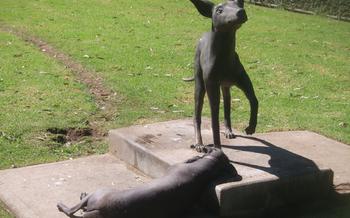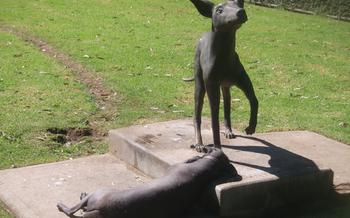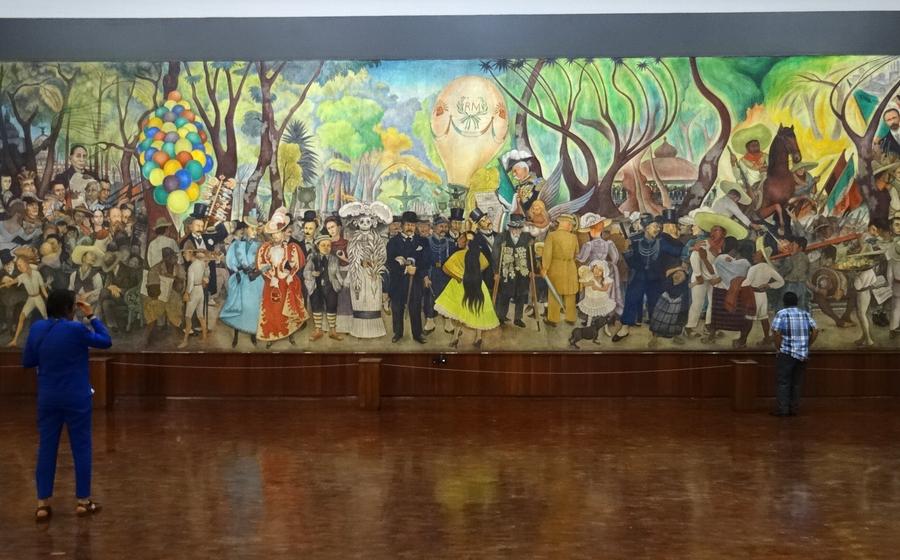
Museo Mural Diego Rivera
- Museo Mural Diego Rivera: A Journey Through Mexican History and Art
- Exploring the Murals: A Visual Narrative
- Diego Rivera's Legacy: Beyond the Museum Walls
- Delving into Mexican History: The Murals as Historical Documents
- Artistic Techniques and Styles: Rivera's Unique Approach
- Interactive Experiences: Engaging with the Murals
- Preservation and Conservation: Ensuring the Murals' Legacy
- Diego Rivera's Impact on Mexican Art and Culture
- Historical Context of the Murals: Mexico in the 20th Century
- The Murals' Reception and Criticism: A Complex Legacy
- Exploring the Museum's Collection Beyond the Murals
- Insider Tip: Enhancing Your Museum Experience
Museo Mural Diego Rivera: A Journey Through Mexican History and Art
The Museo Mural Diego Rivera is a testament to the artistic genius of Diego Rivera, one of Mexico's most celebrated muralists. Housed in the former Palace of Cortés, the museum showcases Rivera's monumental murals, which offer a visual narrative of Mexican history, culture, and social struggles.
Rivera's murals were commissioned by the Mexican government in the 1920s and 1930s as part of a broader effort to promote Mexican identity and national pride following the Mexican Revolution. Rivera embraced this opportunity to create a visual history of Mexico, depicting key events, historical figures, and social movements that shaped the country's past.
The murals are not just a testament to Rivera's artistic skill but also a reflection of his deep commitment to social justice and his belief in the power of art as a catalyst for social change. Through his murals, Rivera sought to give voice to the marginalized and oppressed, shedding light on the struggles of workers, peasants, and indigenous peoples.
Rivera's unique style, characterized by bold colors, dynamic compositions, and a mastery of fresco painting, brings the murals to life, creating a powerful and immersive experience for viewers. His use of pre-Columbian and Mexican folk art motifs further reinforces the connection between the murals and Mexico's rich cultural heritage.
Exploring the Murals: A Visual Narrative
The Museo Mural Diego Rivera's most striking feature is undoubtedly the series of imposing murals that adorn its walls. Created by the renowned Mexican artist Diego Rivera, these breathtaking artworks offer a visual narrative that encompasses Mexican history, culture, and social struggles.
-
The Creation of the World: This mural depicts the birth of the universe, showcasing Rivera's fascination with pre-Columbian mythology and indigenous cultures.
-
Mexico Tenochtitlán: Rivera portrays the Aztec capital city of Tenochtitlán in all its splendor, capturing the beauty and grandeur of ancient Mexican civilization.
-
The Conquest: The mural depicts the arrival of Spanish conquistadors and the subsequent fall of the Aztec Empire, highlighting the devastating impact of colonialism.
-
The Colonial Period: Rivera portrays the oppression and exploitation of the indigenous population under Spanish rule, emphasizing the struggle for independence.
-
The Mexican Revolution: This mural celebrates the Mexican Revolution, depicting the fight for freedom and social justice, and honoring the heroes who led the movement.
-
Contemporary Mexico: Rivera's vision of modern Mexico showcases the country's industrial progress, cultural diversity, and the ongoing struggle for social equality.
Rivera's murals are not merely historical records but powerful expressions of his political and social beliefs. His use of vibrant colors, bold lines, and dynamic compositions creates a visually captivating experience, inviting viewers to engage with the stories and messages embedded within each masterpiece.
Diego Rivera's Legacy: Beyond the Museum Walls
Beyond the walls of the Museo Mural Diego Rivera, the artist's legacy extends far and wide. His contributions to Mexican art and culture are immeasurable, as he played a pivotal role in shaping the country's artistic identity. Rivera's influence can be seen in the work of subsequent generations of Mexican artists, who drew inspiration from his revolutionary techniques and social consciousness. His murals have become iconic symbols of Mexico, gracing public buildings, universities, and cultural institutions across the country.
Preservation and restoration efforts have been undertaken to ensure that Rivera's legacy continues to live on. The Museo Mural Diego Rivera itself is a testament to the importance of preserving his work, as it houses and maintains the largest collection of his murals. Conservation experts have worked tirelessly to protect the murals from deterioration, utilizing advanced techniques to address the challenges posed by their age and environmental factors.
Rivera's work remains relevant in contemporary art and society, as his messages of social justice, equality, and cultural pride continue to resonate with audiences worldwide. His murals have been exhibited in major museums and galleries around the globe, introducing his art to a wider audience and sparking conversations about the power of art to address social issues.
Diego Rivera's legacy is one of innovation, social consciousness, and enduring impact. His murals stand as a testament to his artistic genius and his commitment to using art as a tool for social change. His influence continues to shape the world of art, inspiring and challenging artists to explore new forms of expression and to use their voices to address the pressing issues of our time.
Delving into Mexican History: The Murals as Historical Documents
The murals at the Museo Mural Diego Rivera are not just artistic masterpieces; they are also invaluable historical documents that provide a glimpse into Mexico's rich and complex past. Rivera's murals depict key events and figures from Mexican history, offering a visual narrative of the country's struggles for independence, social justice, and national identity.
Through his murals, Rivera aimed to educate and inspire the Mexican people, fostering a sense of pride in their heritage and a desire for a more equitable society. He used symbols and allegories to convey historical messages, such as the eagle and the serpent representing Mexico's ancient Aztec roots, or the depiction of Emiliano Zapata, a revolutionary leader, as a symbol of peasant resistance.
The murals also offer insights into the social and political climate of Mexico during Rivera's time. They reflect the artist's socialist beliefs and his commitment to social justice, as well as his criticism of capitalism and imperialism. Rivera's portrayal of workers, peasants, and indigenous people as symbols of resistance highlights his deep empathy for the marginalized and oppressed.
By presenting a visual representation of Mexico's history, Rivera's murals contribute to the preservation and understanding of the country's cultural heritage. They serve as a reminder of the struggles and triumphs of the Mexican people and continue to inspire and educate viewers around the world.
Artistic Techniques and Styles: Rivera's Unique Approach
In creating his murals, Diego Rivera showcased his mastery of fresco painting, a technique that involves applying paint to wet plaster. This allowed him to achieve a luminous and durable finish that would stand the test of time. Rivera's innovative use of fresco allowed him to create large-scale works with vibrant colors and intricate details.
Rivera drew inspiration from various sources, including pre-Columbian art and Mexican folk art. He incorporated elements of these traditions into his murals, creating a uniquely Mexican style. His use of bold colors, strong lines, and dynamic compositions resulted in visually striking and emotionally charged artworks.
Throughout his career, Rivera experimented with different artistic styles. In his early works, he adopted a more realistic approach, portraying scenes from Mexican history and everyday life with meticulous detail. However, as he matured as an artist, he embraced a more expressive and symbolic style, using abstraction and allegory to convey his social and political messages.
Rivera's artistic techniques and styles played a crucial role in shaping the Mexican muralism movement. His innovative approach to fresco painting and his unique blend of influences helped establish a new visual language that would become synonymous with Mexican art and identity.
Interactive Experiences: Engaging with the Murals
The Museo Mural Diego Rivera offers a range of interactive experiences to enhance visitors' engagement with the murals and Mexican art. Interactive displays and multimedia presentations provide additional information about Rivera's life, artistic techniques, and the historical context of the murals. Visitors can learn about the symbolism and cultural significance of the murals through interactive activities, such as touchscreens and digital displays.
The museum also organizes workshops, lectures, and educational programs related to the murals and Mexican art. These programs provide opportunities for visitors to engage with experts, participate in hands-on activities, and gain a deeper understanding of Rivera's work and its impact on Mexican culture.
For those unable to visit the museum in person, virtual tours and online resources offer an immersive experience. These virtual platforms allow users to explore the murals in detail, access educational content, and engage with interactive features from the comfort of their own homes.
Through these interactive experiences, the Museo Mural Diego Rivera aims to create a dynamic and engaging environment that fosters a deeper appreciation for Rivera's work and its significance in Mexican art and history.
Preservation and Conservation: Ensuring the Murals' Legacy
The Museo Mural Diego Rivera is committed to preserving and conserving the murals for future generations. The museum employs a team of conservators who regularly inspect and monitor the condition of the murals. They use specialized techniques and materials to clean, repair, and protect the murals from deterioration and damage.
One of the main challenges in preserving the murals is their age and the environmental factors that can affect them. The murals were created in the 1920s and 1930s, and they have been exposed to various environmental conditions over the years. The museum has implemented climate control systems to regulate temperature and humidity levels, which helps to protect the murals from damage caused by fluctuations in temperature and humidity.
Technology plays a crucial role in monitoring and documenting the condition of the murals. The museum uses high-resolution cameras and imaging techniques to create detailed digital records of the murals. These records are used to track changes in the condition of the murals over time and to plan for future conservation efforts.
The preservation and conservation of the murals is an ongoing process that requires careful planning, expertise, and resources. The museum works closely with conservators, scientists, and other experts to ensure that the murals are preserved for future generations and continue to inspire and educate visitors from around the world.
Diego Rivera's Impact on Mexican Art and Culture
Diego Rivera's impact on Mexican art and culture is immeasurable. As a pioneer of the Mexican muralism movement, he played a pivotal role in shaping the country's artistic identity and promoting its cultural heritage on a global scale. His monumental murals, characterized by their vibrant colors, dynamic compositions, and powerful social messages, have become iconic symbols of Mexican art and continue to inspire generations of artists worldwide.
Rivera's murals not only showcased his artistic prowess but also served as a powerful tool for social commentary and political activism. Through his art, he addressed issues of social injustice, class struggle, and the plight of the working class, giving voice to the marginalized and oppressed. His commitment to using art as a vehicle for social change earned him both admiration and controversy, but it also solidified his position as a leading figure in the Mexican art world.
Rivera's influence extended beyond his own artistic practice. He mentored and collaborated with numerous younger artists, including David Alfaro Siqueiros and José Clemente Orozco, who together formed the triumvirate of Mexican muralists. His work also had a profound impact on subsequent generations of Mexican artists, who drew inspiration from his unique style and commitment to social realism.
Rivera's legacy extends far beyond Mexico's borders. His murals have been exhibited internationally, garnering widespread recognition and acclaim. He is considered one of the most significant artists of the 20th century, and his work has been instrumental in raising the profile of Mexican art on the global stage. The establishment of the Museo Mural Diego Rivera, dedicated to preserving and showcasing his monumental murals, stands as a testament to his enduring impact and the profound influence he has had on Mexican art and culture.
Historical Context of the Murals: Mexico in the 20th Century
The creation of Diego Rivera's murals took place against the backdrop of a tumultuous and transformative period in Mexican history. The early 20th century witnessed the Mexican Revolution, a bloody and protracted struggle that reshaped the country's political, social, and cultural landscape. The revolution aimed to dismantle the oppressive regime of Porfirio Díaz and establish a more just and equitable society. Rivera's murals, created in the aftermath of the revolution, reflected the spirit of change and renewal that permeated Mexican society.
Rivera was deeply involved in the social and political movements of his time. He was a staunch supporter of the revolution and his art became a vehicle for expressing his political beliefs and aspirations for a better Mexico. The murals in the Museo Mural Diego Rivera are infused with revolutionary symbolism and imagery, celebrating the struggle for social justice and the empowerment of the working class. Through his art, Rivera sought to create a visual narrative that would inspire and educate the Mexican people, fostering a sense of national identity and pride.
The Murals' Reception and Criticism: A Complex Legacy
Diego Rivera's murals at the Palacio Nacional were met with mixed reactions from the public and critics. While some hailed them as masterpieces that celebrated Mexico's history and culture, others were critical of Rivera's political stance and the inclusion of controversial figures in the murals. The portrayal of Karl Marx, Vladimir Lenin, and other communist leaders in the "History of Mexico" mural drew particular criticism from conservative circles.
Despite the controversy, Rivera's murals gained increasing recognition over time. They became a symbol of Mexican art and culture and were praised for their technical mastery, historical accuracy, and social commentary. However, debates and interpretations surrounding Rivera's legacy continue to this day, with some critics questioning the glorification of certain historical figures and the political motivations behind the murals.
Rivera's work remains a complex and multifaceted body of art that has sparked both admiration and controversy. His murals at the Palacio Nacional stand as a testament to his artistic genius and his commitment to social justice, while also reflecting the complex political and cultural landscape of Mexico in the early 20th century.
Exploring the Museum's Collection Beyond the Murals
While the Museo Mural Diego Rivera is renowned for its impressive collection of Diego Rivera's murals, it also houses a diverse array of other artworks by the renowned Mexican artist and his contemporaries. Visitors can explore galleries showcasing Rivera's easel paintings, drawings, and sketches, which offer a deeper insight into his artistic journey and creative process.
Beyond Rivera's works, the museum features temporary exhibitions and rotating displays that showcase the vibrant and diverse expressions of Mexican art. These exhibitions often highlight the works of emerging and established Mexican artists, providing a platform for them to share their unique perspectives and interpretations of Mexican culture and history.
The museum also offers a range of educational and cultural programs, including workshops, lectures, and film screenings, which delve into the history, techniques, and significance of Mexican art. These programs provide visitors with opportunities to engage with experts, learn about the artistic traditions of Mexico, and gain a deeper understanding of the country's rich cultural heritage.
By exploring the museum's collection beyond the murals, visitors can gain a comprehensive appreciation of Diego Rivera's artistic legacy and immerse themselves in the broader landscape of Mexican art.
Insider Tip: Enhancing Your Museum Experience
To fully appreciate the Museo Mural Diego Rivera and its stunning collection, consider these insider tips to make the most of your visit:
-
Timing is Everything: Aim to visit the museum during the early morning or late afternoon to avoid the peak crowds and bask in a more serene atmosphere, allowing you to immerse yourself in the murals without distractions.
-
Guided Expertise: Take advantage of the museum's guided tours led by knowledgeable experts who can provide fascinating insights into Rivera's life, artistic techniques, and the historical context of the murals, enriching your understanding of these masterpieces.
-
Explore Beyond the Walls: After your visit to the museum, take some time to explore the surrounding Alameda Central park, a beautiful green oasis in the heart of Mexico City. Stroll through its tree-lined paths, admire the historic monuments, and soak in the vibrant atmosphere of this urban retreat.
-
Enhance Your Knowledge: Make use of the museum's educational resources, including audio guides and informative brochures, to deepen your understanding of the murals and Rivera's artistic journey. These resources offer valuable context and insights that will enhance your appreciation of the artwork.
